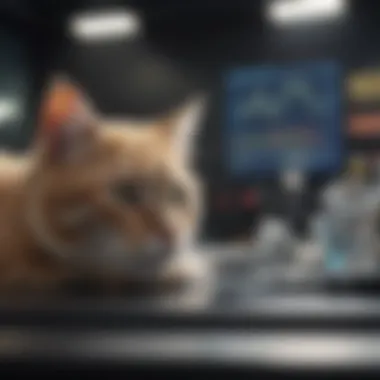Exploring the Link Between Schroders and Feline Symbolism


Intro
The convergence of finance and culture offers some intriguing perspectives, particularly when examining the practices of prominent institutions such as Schroders and the symbolic roles assigned to felines in various socio-economic contexts. Cats have transcended their status as ordinary pets, evolving into symbols of independence, mystery, and wealth. This article aims to dissect the intersection of these two seemingly unrelated subjects: Schroders, a leading global asset management firm, and the metaphorical representation of cats. Through this exploration, we will uncover insights that may enrich our understanding of behavioral studies in the financial sphere.
Research Overview
Summary of Key Findings
The research outlines multiple dimensions in which Schroders engages with cat symbolism. Notably, the firm’s branding strategies often reflect characteristics ascribed to felines, such as agility and independence. A survey of financial literature identifies a recurring theme: cat imagery is frequently utilized in marketing to convey trustworthiness and sophistication. Additionally, the connection between an investor's personality traits and their affinity for cat symbolism provides a new lens through which to view market behavior.
"The relationship between financial methodologies and cultural symbols like cats reveals deeper behavioral tendencies among investors."
Significance of Research
Understanding this intersection has immediate implications for professionals in finance and behavioral studies. As the field increasingly embraces interdisciplinary approaches, insights from feline studies can inform better financial decision-making. By integrating these cultural symbols into finance, Schroders can enhance brand perception while also appealing to the emotional dimensions of investor behavior. This research not only serves to illuminate the unique interplay between these sectors but also sets the foundation for future inquiries into the significance of cultural symbolism in finance.
Methodology
Research Design
To analyze the intricate relationship between Schroders and feline symbolism, a multi-faceted research design was implemented. This includes qualitative interviews with industry experts and quantitative surveys targeting investor perceptions. By employing this dual approach, researchers are able to triangulate data for more reliable findings.
Data Collection Methods
- Interviews: Conducting semi-structured interviews allowed for deep insights into industry views on the symbolism associated with cats.
- Surveys: Distributed online, surveys captured a diverse range of investor thoughts about feline imagery and its perceived impact on financial decisions.
- Literature Review: An extensive review of existing literature provided foundational knowledge about the historical perspectives on cats in cultural contexts.
This methodical approach ensures a well-rounded understanding of how Schroders engages with cat symbolism and its implications for the financial sector.
Understanding Schroders
In the context of this article, understanding Schroders is essential because it bridges the world of finance with broader social and cultural themes. The firm is not only a leader in asset management but also a representative of various investor attitudes and global economic trends. This connection highlights the relevancy of financial institutions in shaping economic landscapes, reflecting behavioral tendencies that resonate beyond boardrooms. By studying Schroders, we can uncover insights that may also apply to the metaphorical aspects of feline symbolism in finance.
History and Foundation
Schroders began as a family-run business in London in 1804. Founded by Johann Friedrich Schroder, the firm initially operated as a private bank. Over time, it shifted its focus towards investment management. Today, Schroders operates in multiple countries, serving a diverse clientele ranging from individuals to large institutions. Recognizing this history is significant as it illustrates how deep roots can influence present-day operations and cultural interpretations related to finance.
The foundation of a company often shapes its values and mission. Schroders emphasizes a commitment to sustainability and responsible investment, which can correlate to the care and responsibility one might associate with pet ownership and feline studies. This growing awareness of ethical finance parallels the increasing interest in the cultural significance of cats, showing how different disciplines can interact meaningfully.
Financial Management Philosophy
Schroders follows a financial management philosophy that integrates research-driven strategies with a deep understanding of market dynamics. The company champions a disciplined approach to investing, focusing on long-term value creation. This methodology ensures that they not only prioritize returns but also consider how their actions affect broader societal outcomes.
This philosophy resonates with behavioral finance by illustrating how investor psychology impacts decision-making. Just as cat owners can develop emotional bonds with their pets, investors can form connections with their assets. Understanding these emotional tendencies can lead to more informed and better financial outcomes. Such considerations help enrich the discourse around finance, shedding light on how human behaviors drive market trends.
Global Impact and Reach
Schroders has a profound global impact. With offices across continents and a diverse client base, it plays a crucial role in shaping investment flows and influencing capital markets. The organization manages billions in assets and commits to transparency and responsible investment practices.
The firm’s reach into various markets allows for a diverse range of insights that can be drawn from different cultural contexts. For example, attitudes toward cats vary widely around the world, reflecting deeper social norms and beliefs. As we examine these threads in the context of Schroders, we can explore how cultural symbolism intersects with financial strategies. This can culminate in a more rounded approach to both investing and understanding societal values.
Ultimately, the intersection between Schroders and cultural symbolism, like that of cats, serves to highlight the importance of understanding socio-economic contexts within financial studies.
The Cultural Significance of Cats


The importance of cat symbolism in various cultural settings is remarkable. Cats, often seen as companions and intimate beings, hold profound significance in societies across the globe. This section examines how felines have become symbols of various ideals and attributes in art, literature, history, and modern views. The relationship between cats and finance may not be immediately obvious, yet understanding this significance can unlock deeper insights into human behavior and economic trends.
Historical Perspectives on Felines
Historically, cats have been revered in many cultures. In ancient Egypt, they were associated with the goddess Bastet, symbolizing protection, fertility, and motherhood. Killing a cat was once punishable by death, illustrating their significance. This historical reverence for cats taps into the broader human relationship with animals and nature, shaping perceptions around safety and stability—key concerns in finance. Moreover, civilizations like the Romans and Greeks recognized the value of cats, often linking them to agriculture by controlling vermin, which indirectly supported economic well-being.
Symbolism in Literature and Arts
Cats have been prevalent figures in literature and the arts for centuries. They often embody traits such as independence, mystery, and grace. From Edgar Allan Poe's sinister tales to the whimsical charm in "The Cat in the Hat" by Dr. Seuss, feline characters elicit a wide range of emotions and lessons. In art, many famous painters like Henriette Ronner-Knip depicted cats in various settings, highlighting their beauty and enigma. These representations reflect societal values and behaviors, providing clues to understanding market sentiments.
Modern Interpretations
In contemporary culture, cats symbolize numerous concepts ranging from luxury to mysticism. The phrase "the internet loves cats" illustrates their profound impact in digital and real-world contexts. As more people adopt cats as pets, their influence on human well-being and mental health is becoming evident. The emotional bond formed with these animals mirrors investment strategies where emotional biases can sway decisions. Understanding the modern cultural implications of cats will aid professionals in finance to comprehend consumer behaviors that impact markets.
"Cats are connoisseurs of comfort." - James Herriot
In summary, the cultural significance of cats is multifaceted and deeply woven into human history. By analyzing their influences across different spheres, we gain valuable insights into behavioral finance and consumer psychology. The interplay between cultural studies and finance offers practical applications for investment strategies, enriching the dialogue between the fields.
Theoretical Frameworks
Understanding the theoretical frameworks within finance is essential for grasping the intricate dynamics at play in the relationship between financial institutions like Schroders and broader cultural significances, such as those found in feline studies. These frameworks provide a lens through which financial behaviors, market trends, and the psychological aspects of decision-making can be analyzed. They allow us to consider various influences—what drives market changes, why investors behave in specific ways, and how external cultural symbols affect the financial choices individuals make.
Behavioral Finance and Its Implications
Behavioral finance emerges as a critical area to explore due to its focus on the psychological factors influencing investors’ decisions. This field challenges the traditional notions of rationality in investing and asserts that emotions and cognitive biases invariably play a role in decision-making processes. For instance, an investor's attachment to their pet cat may lead them to make emotionally driven choices in their financial portfolio.
Investment behaviors often deviate from logical reasoning. Common cognitive biases—like overconfidence and loss aversion—affect how individuals approach their financial strategies. According to behavioral finance theories, users of Schroders services may be influenced by previous experiences and even their home environments, which might include their pets. Thus, understanding these influences is crucial for financial managers to optimize their strategies and client interactions effectively.
Cognitive Biases in Investment Decisions
Cognitive biases represent systematic patterns of deviation from norm or rationality in judgment. Investors at Schroders, like others, can be swayed by various biases, including anchoring, where they depend too heavily on the first piece of information encountered when making decisions, and herd behavior, where individuals follow the actions of a larger group. These patterns can result in irrational market trends and create discrepancies that may not align with fundamental values.
For example, consider the common enthusiasm surrounding certain stocks that might coincide with trends on social media or pop culture, such as the rising popularity of digital pets or animal welfare. Those biases illustrate how perceptions can tilt market behaviors, thus affecting the broader financial landscape and the performance of assets managed by firms like Schroders.
Socio-Economic Influences on Market Trends
Socio-economic factors also play a pivotal role in influencing market dynamics. Variables such as income levels, education, and cultural contexts can dictate how and when individuals feel comfortable investing or spending. In this context, the prominence of cat-related cultural symbolism, such as feline welfare or cat ownership trends, can significantly affect certain sectors in the market, from veterinary services to pet supplies.
Schroders, in aligning its investment strategies with the emerging socio-economic trends connected to animal welfare, stands to gain a better understanding of how cultural values influence consumer behaviors. This awareness can lead to adjusted strategies that not only cater to the current market sentiment but also anticipate future changes influenced by shifting societal norms.
"The intricate ties between culture and finance reveal much about the underlying mechanisms driving market trends."
By appreciating these socio-economic influences, Schroders can enhance its investment decision-making processes, yielding a more comprehensive approach that considers not only financial metrics but also the societal context in which these investments operate.
Intersections between Finance and Feline Studies
Examining the relationship between finance and feline studies presents a unique opportunity to understand both disciplines more deeply. This section explores how these two seemingly unrelated fields interact and what insights they offer. The findings can enhance our appreciation for market dynamics while providing valuable lessons in behavioral tendencies and emotional intelligence. Through this exploration, we will highlight key elements that contribute to a broader understanding of investment strategies and consumer behavior.
Behavioral Insights from Cat Ownership
Owning a cat can significantly influence behavior and decision-making processes. Studies show that pet ownership, particularly of cats, may promote positive psychological outcomes. In terms of finance, this translates to a crucial understanding of how emotional connections can impact financial choices.
Research indicates that individuals who own pets tend to exhibit greater emotional stability and resilience. This can affect their approach to investing, often leading to more thoughtful and patient decisions. Emphasizing these behavioral insights allows financial professionals to tailor their strategies, considering the emotional dimensions of their clients.
The parallels between caring for a cat and making financial decisions can offer valuable insights about patience, nurturing, and responsibility. Cat owners may approach investments with a long-term perspective, acknowledging that, much like feline care, financial growth requires time and careful management.


Market Analogies and Consumer Behavior
Market analogies derived from feline studies can offer interesting insights into consumer behavior. The way consumers interact with products can mirror the behavior exhibited by cats in various contexts. For example, just as cats display curiosity and selective engagement, consumers also exhibit particular patterns in their purchasing habits.
Research in consumer psychology has shown that familiarity and comfort play significant roles in decision-making. Cat owners often create environments that cater to their pets' preferences. Similarly, brands that create consumer-friendly experiences are likely to achieve higher levels of engagement. Understanding these analogies can lead to better marketing strategies that resonate with target audiences.
Additionally, felines exhibit a range of behaviors that can inform brands about consumer loyalty. Just as a cat develops attachment and affinity for its environment, consumers may form loyalty towards brands that provide comfort and satisfaction. This knowledge can be directly applied in tailoring customer experiences and enhancing brand loyalty in financial markets.
Emotional Intelligence and Investment Strategies
Emotional intelligence has become increasingly vital in finance. Investors need to not only analyze data but also understand the emotional undercurrents that affect market behavior. The presence of cats in households can contribute to developing empathy and patience, which are crucial traits for successful investors.
Investors who possess high emotional intelligence can better navigate volatile markets. They can recognize their own emotional responses as well as those of others, helping them make informed decisions. Owners of cats often learn to interpret subtle cues, developing their observational skills. This can translate into a heightened awareness in trading scenarios where understanding the sentiments of both the market and other investors is crucial.
Incorporating these insights into investment strategies can generate more adaptive responses to market fluctuations. A well-rounded approach that blends analytical skills with emotional intelligence enhances the overall effectiveness of financial planning and investment management.
Schroders and Its Engagement with Behavioral Economics
Schroders, as a significant player in the asset management sector, engages with behavioral economics to enhance its investment strategies and understand client behavior more acutely. The essence of this engagement lies in its ability to align investment approaches with the psychological tendencies and emotional drivers of investors. By doing so, Schroders not only seeks to improve portfolio management outcomes but also aims to foster a deeper connection with its client base. The relevance of behavioral economics in finance cannot be overstated, especially as markets become increasingly complex and interconnected.
Research Initiatives and Projects
Schroders participates in a range of research initiatives that explore the intricacies of behavioral finance. These initiatives often result from collaborations with academic institutions and research organizations. They focus on understanding investor behavior, specifically how biases affect decision-making. For example, studies might investigate how overconfidence or loss aversion impacts investment choices. Such projects provide valuable insights that can be integrated into Schroders’ investment strategies. This research is crucial as it aids in identifying trends that might not be apparent through traditional financial analysis.
Integration of Cat Studies in Financial Analysis
The integration of cat studies into financial analysis highlights a unique interdisciplinary approach that Schroders adopts. By examining the behavioral patterns of cat owners and relating these to consumer behaviors in financial markets, Schroders can draw interesting parallels. For instance, the commitment and emotional connection individuals feel toward their pets can inform how they perceive value and risk in investments. Understanding these emotional responses allows Schroders to tailor its services to meet the nuanced needs of clients effectively. The concept of "emotional investment" is an area ripe for exploration, and integrating feline studies offers a fresh lens to examine these dynamics.
Case Studies and Findings
Real-world applications of these theoretical insights can be found in various case studies conducted by Schroders. One case study may focus on how specific behavioral biases led to significant shifts in market trends, particularly during times of economic instability. These findings often reveal that investors' emotional responses can result in non-rational market behaviors, contradicting classical finance theories.
"Understanding emotional influences on investment can lead to more robust strategies and improved financial outcomes."
Such case studies not only highlight the impact of psychological factors on market movements but also reinforce the importance of education in fostering better investment decisions. By sharing these findings, Schroders helps to cultivate a well-informed and adaptive investor community.
Ethical Considerations in Research
Understanding ethical considerations in research is crucial. It involves not just the welfare of animals, but also the integrity of research practices. In the context of the intersection between Schroders and feline studies, these ethical aspects shape how research is conducted and its implications.
Researchers engaged in financial studies that involve animal welfare must adhere to responsible practices. This means ensuring that any implications on cats and related studies do not lead to harm or distress. Striking an ethical balance is vital for credibility in research. Ethical considerations not only affect the treatment of subjects but also the validity of the findings.
Responsible Research Practices
Responsible research practices are paramount in ensuring that studies are conducted ethically and with integrity. This encompasses several key aspects:
- Transparency: Researchers must be clear about their methods, data sources, and how they analyze information. This helps in maintaining trust with both the subjects involved and the audience.
- Informed Consent: Participants should be well-informed about the study, including any potential risks or benefits. Although this is more pertinent to human subjects, analogous ethical considerations can be applied to animal subjects as well.
- Oversight: Involving ethical review boards can help in establishing guidelines. This adds a layer of scrutiny to promote responsible practices.
Following these principles can enhance the quality and acceptability of research outcomes, thereby benefiting both the field of finance and animal studies.
Implications of Findings on Animal Welfare
The implications derived from research findings can have profound effects on animal welfare, particularly in the context of studies related to cats. Examples of these implications include:
- Policy Development: Research outcomes can lead to the formulation of policies that better protect animal rights in financial settings.
- Public Awareness: Findings can elevate public awareness about the treatment of animals and lead to societal changes regarding how animals are viewed and treated.
- Financial Decisions: Investors may take ethical concerns into account when making investment decisions, aligning their portfolios with their values.


Ensuring that this relationship between research outcomes and animal welfare is considered is essential for developing a responsible approach to finance and ethics.
Balancing Financial Gains with Ethical Standards
In any research, particularly with a financial focus, balancing commercial interests with ethical standards is critical. Considerations include:
- Profit vs. Ethics: Organizations must evaluate the extent to which profit motives can overshadow ethical responsibilities. This involves assessing the potential for adverse impacts on animal welfare to drive profit margins.
- Long-term vs. Short-term Gains: Focusing on short-term financial performance could jeopardize long-term sustainability if ethical considerations are neglected. A more conscientious approach can benefit the company’s image and ultimately its bottom line.
- Stakeholder Responsibility: Engaging various stakeholders, including investors and animal welfare organizations, can create a more holistic understanding of the ethical landscape.
Ensuring that financial success does not come at the expense of ethical responsibility leads to a more sustainable practice.
In summary, ethical considerations in research form a foundation by which Schroders' engagement with feline studies can thrive. A commitment to responsible practices contributes to robust outcomes that serve both finance and welfare needs.
Implications for Future Research
The interplay between behavioral finance and feline studies offers unique implications for future research. Understanding this intersection is crucial for academics and professionals. It may reveal insights into market behavior and cultural influences that are often overlooked. The blend of these fields encourages flexibility in research methodologies and perspectives.
Emerging Trends in Behavioral Studies
Recent years have witnessed noteworthy developments in behavioral studies that can enhance our understanding of market dynamics. Emerging trends include the incorporation of psychological factors into financial decision making. Researchers are now focusing more on how emotions and social influences affect investor behavior. This shift allows a broader view of the factors that influence market movements beyond traditional economic indicators. The study of cats, as animals known for their varied personalities, can provide a unique model for understanding human behavior in financial contexts.
- Key trends to monitor:
- Increased focus on the psychological aspects of investor behavior.
- Use of technology in analyzing behavioral patterns.
- Integration of social influences in financial decisions.
These developments promise to deepen the conversation regarding how personal experiences and preferences shape economic actions.
Interdisciplinary Approaches to Understanding Markets
Interdisciplinary approaches are essential in grasping the complex nature of markets. Bringing together finance and zoological studies can yield significant insights. By applying concepts from feline behavior studies, researchers can uncover behavioral patterns that are transferable to human economic activity. The context surrounding cats, their instincts, and social dynamics can serve as useful analogies in finance.
An interdisciplinary approach might include:
- Analyzing cat ownership as an emotional investment which mirrors financial situations.
- Studying the behaviors exhibited by owners and how they relate to market trends.
- Utilizing frameworks used in feline studies to analyze investor behavior.
These approaches encourage collaboration across various fields, broadening the scope and impact of research findings.
Potential Collaborations Between Finance and Feline Research
The potential for collaborations between finance and feline research is inviting. Such partnerships can drive forward new paradigms in understanding investment behavior. By cooperating with veterinary behavioral specialists and animal psychologists, finance professionals can gain fresh insights into emotional intelligence as it relates to market behavior.
Key avenues for collaboration include:
- Development of survey tools that look into pet ownership and its relation to risk-taking in investments.
- Joint studies and workshops designed to educate both fields on the importance of combining emotional intelligence with market analysis.
- Creating case studies that illustrate how feline behavior can inform practices in financial decision-making.
Fostering these collaborations will encourage a more nuanced understanding of the emotional landscapes influencing financial markets, ultimately enriching both disciplines.
Concluding Thoughts
This section highlights the importance of concluding thoughts in the context of this article about Schroders and feline studies. It serves as a valuable reflection point, prompting readers to synthesize the diverse elements presented throughout the discussion.
Reflecting on the Analysis
The analysis presented in this article encompasses various dimensions. One key aspect is the relation between the financial strategies employed by Schroders and the cultural significance of cats in society. Observing these elements unveils a unique intersection where finance meets animal studies, shedding light on how human behavior influences market dynamics. Throughout the sections, various frameworks have been discussed, including behavioral finance and emotional intelligence, which offer insight into the investing psyche. These concepts are essential as they aid in understanding the underlying motivations behind investment decisions. By reflecting on this analysis, readers gain an appreciation for the complexity of finance and its ties to wider cultural themes.
Final Insights into Schroders and Feline Studies
In closing, the relationship between Schrdoers and feline studies reveals more than mere interest; it highlights the interconnectedness of seemingly unrelated fields. The exploration of behavioral economics in this context opens new avenues for thought and future research. Understanding how cat symbolism influences investment behaviors provides a nuanced layer to financial studies. The insights garnered from this discussion are applicable not only for researchers but also for finance professionals seeking to enhance their strategies. As this relationship evolves, it suggests a fertile ground for further studies, urging a more interdisciplinary approach to finance and behavioral studies.
"The intersectionality of finance and cultural symbolism provides a richer understanding of market behaviors, emphasizing the need for continuous interdisciplinary exploration."
This article prompts ongoing discussions, advocating for a deeper understanding of both finance and feline studies, and their potential implications moving forward.



